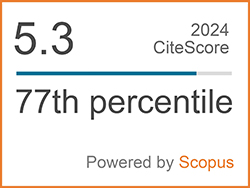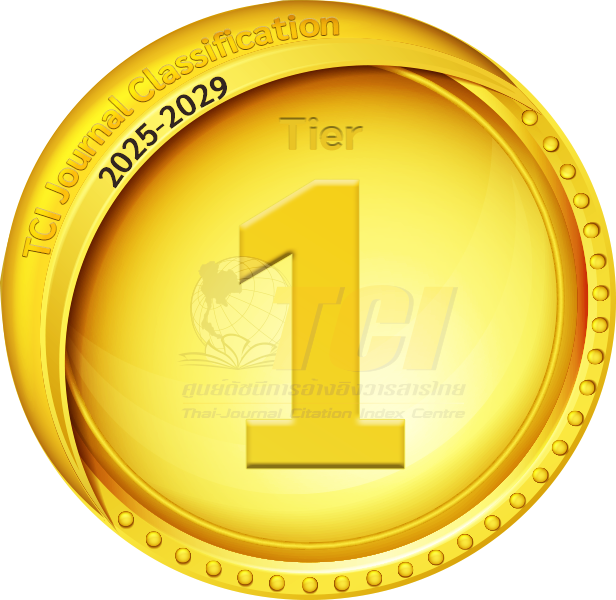Synthesis and Characterization of BiVO4/S,N-CQDs as Photoelectrochemical Water Splitting Material
Abstract
Keywords
[1] A. M. M. I. Qureshy, M. Ahmed, and I. Dincer, “Performance assessment study of photo-electro-chemical water-splitting reactor designs for hydrogen production,” International Journal of Hydrogen Energy, vol. 44, no. 18, pp. 9237–9247, Apr. 2019, doi: 10.1016/j.ijhydene.2019. 01.280.
[2] A. M. Abdalla, S. Hossain, O. B. Nisfindy, A. T. Azad, M. Dawood, and A. K. Azad, “Hydrogen production, storage, transportation and key challenges with applications: A review,” Energy Conversion and. Management, vol. 165, pp. 602–627, Jun. 2018, doi: 10.1016/j.enconman. 2018.03.088.
[3] B. C. Tashie-Lewis and S. G. Nnabuife, “Hydrogen production, distribution, storage and power conversion in a hydrogen economy - A technology review,” Chemical Engineering Journal Advances, vol. 8, Nov. 2021, Art. no. 100172, doi: 10.1016/j.ceja.2021.100172.
[4] M. El Ouardi, A. El Idrissi, M. Arab, M. Zbair,
H. Haspel, M. Saadi, and H. Ait Ahsaine, “Review of photoelectrochemical water splitting: From quantitative approaches to effect of sacrificial agents, oxygen vacancies, thermal and magnetic field on (photo)electrolysis,” International Journal of Hydrogen Energy, vol. 51, pp. 1044–1067, Jan. 2024, doi: 10.1016/ j.ijhydene.2023.09.111.
[5] M. G. Walter, E. L. Warren, J. R. McKone, S. W. Boettcher, Q. Mi, E. A. Santori, and N. S. Lewis, “Solar water splitting cells,” Chemical Reviews, vol. 110, no. 11, pp. 6446–6473, Nov. 2010, doi: 10.1021/cr1002326.
[6] M. Kumar, B. Meena, P. Subramanyam, D. Suryakala, and C. Subrahmanyam, “Recent trends in photoelectrochemical water splitting: The role of cocatalysts,” NPG Asia Materials, vol. 14, no. 1, p. 88, Dec. 2022, doi: 10.1038/ s41427-022-00436-x.
[7] P. Mane, I. V. Bagal, H. Bae, A. N. Kadam, V. Burungale, J. Heo, S. W. Ryu, and J. S. Ha, “Recent trends and outlooks on engineering of BiVO4 photoanodes toward efficient photoelectrochemical water splitting and CO2 reduction: A comprehensive review,” International Journal of Hydrogen Energy, vol. 47, no. 94, pp. 39796–39828, Dec. 2022, doi: 10.1016/j.ijhydene.2022.09.146.
[8] M. Tayebi and B. K. Lee, “Recent advances in BiVO4 semiconductor materials for hydrogen production using photoelectrochemical water splitting,” Renewable and Sustainable Energy Reviews, vol. 111, pp. 332–343, Sep. 2019, doi: 10.1016/j.rser.2019.05.030.
[9] J. Wang, T. Zhou, Y. Zhang, L. Li, C. Zhou, J. Bai, J. Li, H. Zhu, and B. Zhou, “Type-II heterojunction CdIn2S4 /BiVO4 Coupling with CQDs to improve PEC water splitting performance synergistically,” ACS Applied Materials & Interfaces, vol. 14, no. 40, pp. 45392–45402, Oct. 2022, doi: 10.1021/acsami. 2c12618.
[10] R. Atchudan, S. H. Kishore, T. N. J. I. Edison, S. Perumal, R. Vinodh, A. K. Sundramoorthy, R. S. Babu, M. Alagan, and Y. R. Lee, “Highly fluorescent carbon dots as a potential fluorescence probe for selective sensing of ferric ions in aqueous solution,” Chemosensors, vol. 9, no. 11, p. 301, Oct. 2021, doi: 10.3390/ chemosensors9110301.
[11] R. Liu, J. Zhang, M. Gao, Z. Li, J. Chen, D. Wu, and P. Liu, “A facile microwave-hydrothermal approach towards highly photoluminescent carbon dots from goose feathers,” RSC Advances, vol. 5, no. 6, pp. 4428–4433, 2015, doi: 10.1039/ C4RA12077A.
[12] D. Yao, A. Liang, and Z. Jiang, “A fluorometric clenbuterol immunoassay using sulfur and nitrogen doped carbon quantum dots,” Microchimica Acta, vol. 186, no. 5, p. 323, May 2019, doi: 10.1007/s00604-019-3431-8.
[13] Y. Park, K. J. McDonald, and K. S. Choi, “Progress in bismuth vanadate photoanodes for use in solar water oxidation,” Chemical Society Reviews, vol. 42, no. 6, pp. 2321–2337, 2013, doi: 10.1039/C2CS35260E.
[14] P. Casati, M. V. Lara, and C. S. Andreo, “Induction of a C4-Like Mechanism of CO2 fixation in Egeria densa, a submersed aquatic species,” Plant Physiology, vol. 123, no. 4, pp. 1611–1622, Aug. 2000, doi: 10.1104/pp.123.4.1611.
[15] U.S. Fish and Wildlife Service. “Ecological risk screening summary Brazilian waterweed.” fws.gov. https://www.fws.gov/sites/default/files/ documents/Ecological-Risk-Screening-Summary-Brazilian-Waterweed.pdf (accessed May 31, 2015).
[16] M. Yarrow, V. H. Marín, M. Finlayson, A. Tironi, L. E. Delgado, and F. Fischer, “The ecology of Egeria densa planchón (Liliopsida: Alismatales): A wetland ecosystem engineer?,” Revista Chilena de Historia Natural, vol. 82, no. 2, Jun. 2009, doi: 10.4067/S0716-078X2009000200010.
[17] C. G. De Azevedo, R. J. Dos Santos, C. T. Hiranobe, A. F. Zanette, A. E. Job, and M. J. Silva, “The invasive Egeria densa macrophyte and its potential as a new renewable energy source: A study of degradation kinetics and thermodynamic parameters,” Science of The Total Environment, vol. 856, Jan. 2023, Art. no. 158979, doi: 10.1016/j.scitotenv.2022.158979.
[18] L. Cui, X. Ren, M. Sun, H. Liu, and L. Xia, “Carbon dots: Synthesis, properties and applications,” Nanomaterials, vol. 11, no. 12, p. 3419, Dec. 2021, doi: 10.3390/nano11123419.
[19] X. Álvarez, Á. Cancela, V. Freitas, E. Valero, Á. Sánchez, and C. Acuña-Alonso, “Hydrothermal carbonization and pellet production from Egeria densa and Lemna minor,” Plants, vol. 9, no. 4, p. 425, Mar. 2020, doi: 10.3390/plants9040425.
[20] Y. Miao, J. Liu, L. Chen, H. Sun, R. Zhang, J. Guo, and M. Shao, “Single-atomic-Co cocatalyst on (040) facet of BiVO4 toward efficient photoelectrochemical water splitting,” Chemical Engineering Journal, vol. 427, Jan. 2022, Art. no. 131011, doi: 10.1016/j.cej.2021.131011.
[21] C. Wang, X. Lin, C. G. Schäfer, S. Hirsemann, and J. Ge, “Spray synthesis of photonic crystal based automotive coatings with bright and angular‐dependent structural colors,” Advanced Functional Materials, vol. 31, no. 9, Feb. 2021, Art. no. 2008601, doi: 10.1002/adfm.202008601.
[22] S. I. Park, Y. J. Quan, S. H. Kim, H. Kim, S. Kim, D. M. Chun, C. S. Lee, M. Taya, W. S. Chu, and S. H. Ahn, “A review on fabrication processes for electrochromic devices,” International Journal of Precision Engineering and Manufacturing, vol. 3, no. 4, pp. 397–421, Oct. 2016, doi: 10.1007/ s40684-016-0049-8.
[23] C. Hu, Q. Chen, M. Tian, W. Wang, J. Yu, and L. Chen, “Efficient combination of carbon quantum dots and BiVO4 for significantly enhanced photocatalytic activities,” Catalysts, vol. 13, no. 3, p. 463, Feb. 2023, doi: 10.3390/ catal13030463.
[24] Y. A. Asmara, A. R. Maharani, L. S. Aulia, and I. A. D. Astuti, “Perbandingan sifat optik cdots berbahan daun binahong (anredera scandes l.) segar dan kering menggunakan metode bottom up,” Jurnal Inovasi Penelitian dan Pembelajaran Fisika, vol. 3, no. 2, 2022, doi: 10.26418/jippf. v3i2.56837.
[25] R. Behnood and G. Sodeifian, “Novel ZnCo2O4 embedded with S, N-CQDs as efficient visible-light photocatalyst,” Journal of Photochemistry and Photobiology A: Chemistry, vol. 405, Jan. 2021, Art. no. 112971, doi: 10.1016/j.jphotochem. 2020.112971.
[26] O. A. Aladesuyi and O. S. Oluwafemi, “Synthesis of N, S co-doped carbon quantum dots (N,S-CQDs) for sensitive and selective determination of mercury (Hg2+) in Oreochromis niloctus (Tilapia fish),” Inorganic Chemistry Communications, vol. 153, Jul. 2023, Art. no. 110843, doi: 10.1016/j.inoche.2023.110843.
[27] Y. Deng, J. Qian, Y. Zhou, and F. Lu, “Regulatory preparation of N/S Doped carbon quantum dots and their applications as Fe(III) ion sensors,” ChemistrySelect, vol. 5, no. 17, pp. 5306–5311, May 2020, doi: 10.1002/slct.202000039.
[28] T. Teymoorian, N. Hashemi, M. H. Mousazadeh, and Z. Entezarian, “N, S doped carbon quantum dots inside mesoporous silica for effective adsorption of methylene blue dye,” SN Applied Sciences, vol. 3, no. 3, p. 305, Mar. 2021, doi: 10.1007/s42452-021-04287-z.
[29] G. Li, Y. Bai, and W. F. Zhang, “Difference in valence band top of BiVO4 with different crystal structure,” Materials Chemistry and Physics, vol. 136, no. 2–3, pp. 930–934, Oct. 2012, doi: 10.1016/j.matchemphys.2012.08.023.
[30] H. Nezzal, S. Rahmane, E. G. Temam, M. Al-Abri, H. H. Kyaw, B. Gasmi, M. Althamthami, H. B. Temam, and J. Hu, “Photo-deposition of AgO thin films on TiO2 substrate for (P-N) hetero-junction applications: Considering the degree of contamination,” Journal of Alloys and Compounds, vol. 1010, Jan. 2025, Art. no. 177331, doi: 10.1016/j.jallcom.2024.177331.
[31] F. Qin, Y. Ma, S. Zheng, C. Hu, L. Wei, R. Yang, Y. Ma, and C. Zhang, “Construction of novel Z-Scheme N-CQDs/Sn3O4 heterojunction for excellent photocatalytic degradation of organic pollutant,” Journal of Cluster Science, vol. 33, no. 3, pp. 913–923, May 2022, doi: 10.1007/ s10876-021-02020-9.
[32] M. Sumadiyasa and I. B. S. Manuaba, “Determining crystallite size using Scherrer formula, Williamson-Hull plot, and particle size with SEM,” Buletin Fisika, vol. 19, no. 1, p. 28, Jul. 2018, doi: 10.24843/BF.2018.v19.i01.p06.
[33] T. Liu, Z. Cui, J. Zhou, Y. Wang, and Z. Zou, “Synthesis of pyridinic-rich N, S co-doped carbon quantum dots as effective enzyme mimics,” Nanoscale Research Letters, vol. 12, no. 1, p. 375, Dec. 2017, doi: 10.1186/s11671-017-2149-y.
[34] X. Cao, Y. Gu, H. Tian, Y. Fang, D. Johnson, Z. Ren, C. Chen, and Y. Huang, “Microemulsion synthesis of ms/tz-BiVO4 composites: The effect of pH on crystal structure and photocatalytic performance,” Ceramics International, vol. 46, no. 13, pp. 20788–20797, Sep. 2020, doi: 10.1016/j.ceramint.2020.05.048.
[35] L. Chen, S. F. Yin, R. Huang, Q. Zhang, S. L. Luo, and C. T. Au, “Hollow peanut-like m-BiVO4: facile synthesis and solar-light-induced photocatalytic property,” CrystEngComm, vol. 14, no. 12, p. 4217, 2012, doi: 10.1039/ c2ce06684j.
[36] P. Brack, J. S. Sagu, T. A. N. Peiris, A. McInnes, M. Senili, K. G. U. Wijayantha, F. Marken, and E. Selli, “Aerosol‐assisted CVD of bismuth vanadate thin films and their photoelectrochemical properties,” Chemical Vapor Deposition, vol. 21, no. 1-2-3, pp. 41–45, Mar. 2015, doi: 10.1002/ cvde.201407142.
[37] F. F. Abdi and R. van de Krol, “The nature and light-dependence of bulk recombination in co-pi catalyzed BiVO4 photoanodes,” Journal of Physical Chemistry C, vol. 116, no. 17, pp. 9398-9404, Apr. 2012, doi: 10.1021/jp3007552.
[38] P. C, J. Schuch, B. Kaiser, and W. Jaegermann, “The determination of electrochemical active surface area and specific capacity revisited for the system MnOx as an oxygen evolution catalyst,” Zeitschrift für Physikalische Chemie, vol. 234, no. 5, pp. 979–994, May 2020, doi: 10.1515/zpch-2019-1514.
[39] T. Zhou, S. Chen, J. Wang, Y. Zhang, J. Li, J. Bai, and B. Zhou “Dramatically enhanced solar-driven water splitting of BiVO4 photoanode via strengthening hole transfer and light harvesting by co-modification of CQDs and ultrathin β-FeOOH layers,” Chemical Engineering Journal, vol. 403, Jan. 2021, Art. no. 126350, doi: 10.1016/j.cej.2020.126350.
DOI: 10.14416/j.asep.2025.05.006
Refbacks
- There are currently no refbacks.
 Applied Science and Engineering Progress
Applied Science and Engineering Progress







